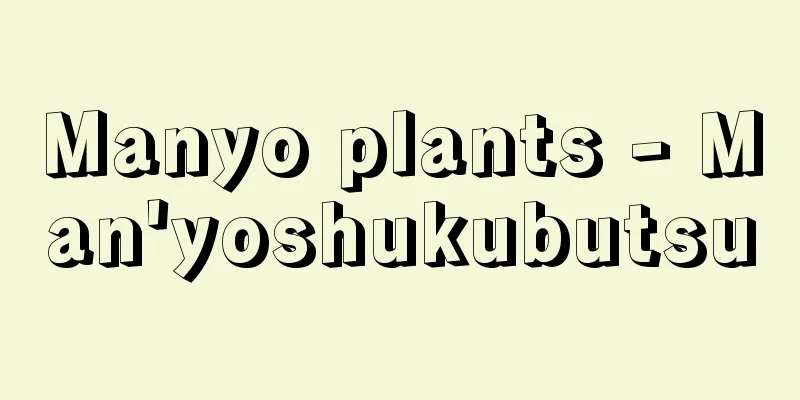Manyo plants - Man'yoshukubutsu

|
This refers to the plants that are written about in the Manyoshu, which number about 160 species. By learning about Manyo plants, we can clarify the use of and interest in plants by the Manyo people, such as cultivated plants at the time, introduced plants, useful plants for food, dyes, fiber, etc., flowers in gardens, flowers enjoyed outdoors, and ways of decorating with flowers. Edible plants included grains such as rice, foxtail millet, millet, and wheat, vegetables such as turnip, winter mallow, taro, melon, and Chinese chive, and fruits such as chestnut, pear, peach, plum, jujube, and Chinese radish, all of which were thought to have been cultivated (the names in parentheses are those used at the time).Other edible plants included wild plants such as water hyacinth, Konagi, Japanese parsley, Nobiru, Yomena (Uhagi), Okera (Ukera), Sumire, Kuroguwai (Egu), and water chestnut, as well as matsutake mushrooms, and freshwater and seaweeds such as Ashitsuki, Hondawara (Nanoriso), Miru, and Wakame seaweed. Plants that were introduced from overseas include ornamental plants as well as grains and vegetables. These include flowering trees such as plum, peach, Japanese plum, Japanese plum (hanezu), Tachibana, and trifoliate orange, as well as garden trees such as weeping willows, and flowering plants such as lotus (some of which grow wild), cockscomb, safflower, and day lilies, totaling 11 species, with 7 trees and 4 flowering plants. On the other hand, among the plants native to Japan, there are ornamental plants that are thought to have been cultivated in gardens, and are named after characters such as yado (inn) (written as yado, yado, muroto, yadozen, or sodo), kakitsu (within a fence), kine (hedge), kakima (to plant), and makaku (to sow). There are 12 types of beautiful flowering trees: Yamabuki, Azalea, Japanese bush clover, Camellia, Wisteria, Cherry, Deutzias, Azalea, Hydrangea, Pear, Chinaberry, and Silk tree, and three types of garden trees: Pine, Bamboo, and Maple. There are also three types of flowering plants: Dianthus, Lily, and Pampas Grass (such as Hanasuki). Of these, it is unclear whether Pampas Grass was actively planted, but if we include it in garden plants, there are 18 species of native Japanese plants. Adding the 11 introduced plants mentioned above, there are a total of 29 species of trees and flowers planted in the gardens of the Man'yoshu people. [Hiroshi Yuasa] Flower Lovers of the Manyo PeriodOf the 29 species planted in the garden, 22 are trees and 7 are flowering plants, with trees overwhelmingly in the majority. This becomes even clearer when wild species are also considered. There are 16 species of native trees with beautiful flowers, 12 of which are also cultivated. In contrast, there are 20 species of grasses with beautiful flowers, but only four show signs of being cultivated. As for Manyo plants, there are almost equal numbers of herbaceous plants (82 species) and woody plants, bamboo, and bamboo (78 species), so it can be said that a preference for flowering trees is clearly reflected in the cultivation of these plants. This trend can also be seen from the total number of times each plant is mentioned in poems. Among Manyo plants, the most frequently written about plant is the bush clover with 141 poems, followed by the plum tree with 118, followed by the pine tree with 79, the Japanese laurel tree with 68, and the cherry tree with 50. Meanwhile, among herbaceous plants, reeds rank highly with 50, sedges (including Japanese kaya and Japanese silver grass) with 49, and silver grass (including Japanese kaya and Japanese silver grass) with 47. Among the most beautiful flowering plants, the dianthus comes in first with 26 poems, followed by the ominaeshi with 14, the lily with 10, and the iris with 7. Also, the appreciation of wildflowers varies depending on the season, with the only beautiful spring flowers that appear being the violet, the pulsatilla nigra, and the dogtooth violet. In contrast, 15 kinds of beautiful flowers and herbs are written about from summer to autumn, and Yamanoue no Okura's poem about the seven kinds of autumn herbs (Volume 8: "Hagi flowers, otobana, kuzu flowers, dianthus flowers, ominaeshi, fujihakama, and asagao flowers") also focuses on flowers. However, the Manyoshu does not have the seven herbs of spring, and even violets, the representative flower of spring, are included as herbs to be picked, as sung by Yamabe no Akahito (Volume 8: "I came to the fields in spring to pick violets, and I slept there all night, longing for the fields."). It seems that the people of the Manyoshu, who had spent a harsh winter, looked at edible herbs in the spring (all the notations in the poem are from Shogakukan's "Complete Collection of Japanese Classical Literature: Manyoshu"). [Hiroshi Yuasa] Plants and the lives of the Manyo peopleFlowers were also used for dyeing. Flowers such as iris, dayflower, cockscomb, and Chinese knotweed were dyed by rubbing directly onto the surface, a process called "hanazuri." Other flowers used for dyeing include madder, purple, mountain eye, oak, and alder. Volume 12 contains the lyrics "Purple is dyed with ash, at the crossroads of the eighty-year-old street of Tsubaki-chi, who is the child I meet?", which shows that purple was mordanted with camellia ash. Hemp was the main fiber used in the Manyo period, but wisteria fiber was also preserved as work clothes. Volume 3 contains the poem, "The wisteria robes of the salt-roasted robes of the Suma fishermen are so far away that I have yet to wear them." Fiber was also extracted from the bark of the paper mulberry tree and used to make ropes, ropes, and clothing (thin white cloth). Mats for tatami mats, straw pillows, and straw for eating were made from the leaves of the wild rice plant. Sedge was also used to make sugegasa hats and suga pillows. Timber was obtained not only from forests, but also from plantations. Volume 10 reads, "Mist hangs from the branches of the cedars planted by the ancients. Spring has come." Tachibana trees were lined up (Volume 2: "I walk in the shadows of the tachibana trees, at the crossroads of the road, missing my younger sister, who is thinking of something"), and willows decorated the main streets of the capital (Volume 19: "When I look at the budding willows on a spring day, I think of the main streets of the capital"). The Man'yoshu people picked, admired and displayed flowers, but they never brought them indoors, and not a single poem about ikebana has been written about it. The only poem written about indoor ikebana is about lily flower arrangements (Volume 18, "In the light of the oil fire, I see my ikebana, the lilies are smiling."). In addition to flower arrangements, flowers were also worn or displayed as headpieces, tied up, hanging, tucked into sleeves, or pierced into jewels. Plants used for flower arrangements and headpieces included yamabuki, wisteria, cherry blossoms, bush clover, plum, willow, and iris, and were more often displayed by men than women. From these facts, it can be said that the Man'yoshu people's use of flowers was somewhat different from that of modern times. Botanical gardens that cultivate Manyo plants include the Kokubunji Manyo Botanical Garden (Kokubunji, Tokyo) and the Kasuga Taisha Shrine Garden Manyo Botanical Garden (Nara). [Hiroshi Yuasa] "Manyo Plants and the Scientific Aspects of Ancient People, by Takuji Koshimizu (1950, Osaka Shimbun)" ▽ "Manyo Grasses, Trees, and Flowers, by Takuji Koshimizu (1970, Asahi Shimbun)" ▽ "New Thoughts on Manyo Plants, Revised Edition, by Osamu Matsuda (1970, Shakai Shisosha)" ▽ "Manyo Flowers, by Mitsuru Sakurai (1984, Yuzankaku Publishing)" [References] | |Source: Shogakukan Encyclopedia Nipponica About Encyclopedia Nipponica Information | Legend |
|
『万葉集』に詠まれている植物をいい、その数は160種ほどである。万葉植物を知ることによって、当時の栽培植物、渡来植物、食用・染料・繊維などの有用植物、庭の花、野外で観賞された花、花の飾り方など、万葉人の植物利用や関心が明らかにできる。 食用植物にはイネ、アワ、キビ(きみ)、ムギなどの穀物、カブ(あおな)、フユアオイ(あおい)、サトイモ(うも)、ウリ、ニラ(くくみら)などの野菜、クリ、ナシ、モモ、スモモ、ナツメ、タチバナ類などの果実があり、いずれも栽培下にあったと考えられる(括弧(かっこ)内は当時の呼称)。ほかにもミズアオイ(なぎ)、コナギ、セリ、ノビル、ヨメナ(うはぎ)、オケラ(うけら)、スミレ、クログワイ(えぐ)、ヒシなどの野草やマツタケ(あきのか)、およびアシツキ、ホンダワラ(なのりそ)、ミル、ワカメなどの淡水藻、海藻も食用とされていた。 海外から渡来した植物には、穀物や野菜のほか、観賞植物がある。渡来した観賞植物には、花木としてはウメ、モモ、スモモ、ニワウメ(はねず)、タチバナ、カラタチ、庭木としてはシダレヤナギがあり、草花としてはハス(自生もある)、ケイトウ(からあい)、ベニバナ(くれない)、ヤブカンゾウがあり、その数は樹木7、草花4の計11種である。一方、日本に自生する植物のうち、宿(やど)(屋戸、夜戸、室戸、屋前、屋外と書く)、垣内(かきつ)、垣根、垣間、植える、播(ま)くなどの表現を伴い、庭で栽培されていたとみられる観賞植物がある。花の美しい木としてはヤマブキ、アセビ、ハギ、ツバキ、フジ、サクラ、ウツギ、ツツジ、アジサイ、ナシ、センダン、ネムノキの12種があり、庭木としてはマツ、タケ、カエデの3種がある。また、草花にはナデシコ、ユリ、ススキ(ハナススキなど)の3種がある。このうち、ススキは積極的に植えられたかどうかは不明であるが、いちおう庭の植物に含めると日本の自生植物は18種となる。これに前出の渡来植物11種を加えた29種が、万葉人の庭に植えられた樹木と草花ということになる。 [湯浅浩史] 万葉人の花好み庭に植えられた29種のうち、樹木は22種、草花は7種で、圧倒的に樹木のほうが多い。これは、野生種を含めて考えると、いっそうはっきりする。花の美しい自生の樹木は16種で、このうち12種は栽培もされている。これに対して花の美しい草は20種を数えるが、栽培されている形跡があるのはわずかに4種である。万葉植物は、草本類が82種、木本類とタケ・ササ類が78種と、ほぼ同数となるので、明らかに栽培には花木好みが現れているといえる。この傾向は、個々の植物が歌にどのくらい詠まれているかという総数からもつかむことができる。 万葉植物のうち、もっとも多く詠まれた植物はハギで141首、これに次ぐのがウメの118首、さらにマツ79首、タチバナ68首、サクラ50首と続く。一方、草本類ではアシ50首、スゲ(スガも含む)49首、ススキ(カヤ、オバナなども含む)47首が上位を占める。花の美しい草ではナデシコが1位で26首詠まれ、オミナエシ14首、ユリ10首、カキツバタ7首などがこれに続く。また、野の花の観賞は季節に差があり、春の美しい草花はスミレ、オキナグサ(ねっこぐさ)、カタクリ(かたかご)くらいしか登場しない。これに対し、夏から秋にかけては15種の花の美しい草が詠まれ、山上憶良(やまのうえのおくら)の秋の七種(くさ)の歌(巻8「萩(はぎ)の花 尾花葛花(をばなくずはな) なでしこが花 をみなへし また藤袴(ふぢはかま) 朝顔(あさがほ)が花」)も花を中心に据えた選択である。ところが、『万葉集』には春の七草がなく、春の代表花であるスミレですら、山部赤人(やまべのあかひと)が歌ったように摘み草の対象にされていた(巻8「春の野に すみれ摘みにと 来(こ)し我(われ)そ 野をなつかしみ 一夜寝(ひとよね)にける」)。厳しい冬を過ごした万葉人は、春にはまず、食用として草花をみていたようである(歌の表記はすべて小学館『日本古典文学全集・萬葉集』による)。 [湯浅浩史] 植物と万葉人の生活花は染色にも用いられた。カキツバタ、ツユクサ、ケイトウ、コナギなどの花は、直接にすり付ける「花摺(はなずり)」によって染色した。このほか、アカネ、ムラサキ、ヤマアイ、クヌギ(つるばみ)、ハンノキも染色に使われている。巻12には「紫(むらさき)は 灰(はひ)さすものそ 海石榴市(つばきち)の 八十(やそ)の衢(ちまた)に 逢(あ)へる児(こ)や誰(たれ)」と歌われており、ムラサキはツバキの灰で媒染されていたことがわかる。 万葉時代の繊維はアサがおもに使われたが、フジの繊維も作業着として残されていた。巻3には「須磨(すま)の海人(あま)の 塩焼(しほや)き衣(きぬ)の 藤衣(ふぢころも) 間遠(まとほ)にしあれば いまだ着なれず」と詠まれている。コウゾの樹皮からも繊維がとれ、縄(たく縄)、綱(たく綱)や衣料(白細(しろたえ))にされた。マコモの葉からは畳薦(たたみごも)、薦枕(こもまくら)、食薦(すごも)がつくられた。スゲも菅笠(すげがさ)、菅枕(すがまくら)に使われた。 材は山林からの利用だけではなく植林によっても得ていた。巻10には「古(いにしへ)の 人の植(う)ゑけむ 杉(すぎ)が枝(え)に 霞(かすみ)たなびく 春は来(き)ぬらし」と詠まれている。タチバナは並木にされていたし(巻2「橘(たちばな)の影(かげ)踏む道の 八衢(やちまた)に 物をそ思ふ 妹(いも)に逢はずして」)、ヤナギも都の大路を飾っていた(巻19「春の日に 萌(は)れる柳を 取り持ちて 見れば都の 大路(おほち)し思ほゆ」)。 万葉人は花を手折り、観賞し、飾ったが、室内にいけることはなかったようで、いけ花は一首も歌われていない。室内ではわずかにユリの花縵(はなかずら)が詠まれているにすぎない(巻18「油火(あぶらひ)の 光に見ゆる 我(わ)が縵 さ百合(ゆり)の花の 笑(ゑ)まはしきかも」)。花縵のほか、挿頭華(かざし)、結(ゆ)ひ垂(た)れ、袖(そで)に扱(こき)入れ、袖に受ける、玉に貫(ぬ)くなどして花を身につけたり、飾ったりした。花縵や挿頭華に使われた植物にはヤマブキ、フジ、サクラ、ハギ、ウメ、ヤナギ、ショウブなどがあり、女性よりも男性が飾ることが多かった。これらのことから、万葉人の花利用には現代とは趣(おもむき)を異にする面もあったといえる。 なお、万葉植物を植栽する植物園には、国分寺万葉植物園(東京都国分寺市)、春日(かすが)大社神苑萬葉植物園(奈良市)などがある。 [湯浅浩史] 『小清水卓二著『萬葉植物と古代人の科学性』(1950・大阪新聞社)』▽『小清水卓二著『万葉の草・木・花』(1970・朝日新聞社)』▽『松田修著『増訂・萬葉植物新考』(1970・社会思想社)』▽『桜井満著『万葉の花』(1984・雄山閣出版)』 [参照項目] | |出典 小学館 日本大百科全書(ニッポニカ)日本大百科全書(ニッポニカ)について 情報 | 凡例 |
<<: Manyo Daishouki - Man'yo Daishouki
>>: A brief explanation of the Manyoshu - Manyoshuryakuge
Recommend
Clarke, FW
…To explain the bonding patterns of compounds con...
Zudayakushu - Zudayakushu
A perennial herb of the Saxifragaceae family (illu...
Supernumerary teeth
What is the disease? The tooth-forming primordium...
Sedimentation velocity
…This phenomenon is called free settling. The phe...
Saussurea pulchella (English spelling) Saussurea pulchella
…[Mitsuru Hotta] [Aya Nitta]. … *Some of the term...
Edwin Smith papyri
…It was probably after the Egyptian civilization ...
Scutellaria - Golden
〘Noun〙① A perennial plant of the Lamiaceae family....
Kamuruchi (English spelling) snake head
A freshwater fish belonging to the family Cobweb ...
Herschel, Sir John Frederick William
Born: March 7, 1792, Slough [Died] May 11, 1871. C...
Local electric field coefficient
…The electric field F acting on atoms in a unifor...
Carotid sinus reflex
A reflex phenomenon in which arterial pressure dro...
Plumularia setacea
Phylum Cnidaria, Class Hydrozoa, Order Leptothecat...
Vegetable weevil (Listroderes obliquus)
Belonging to the family Curculionidae in the order...
Okroshka - Okuroshka
...In any case, the recipe is relatively simple, ...
pekoe
… The grade of black tea is often determined by t...









